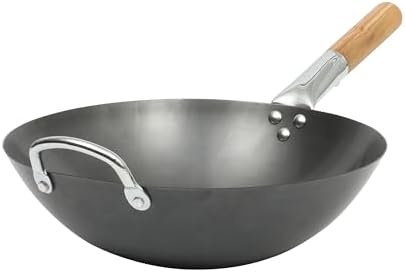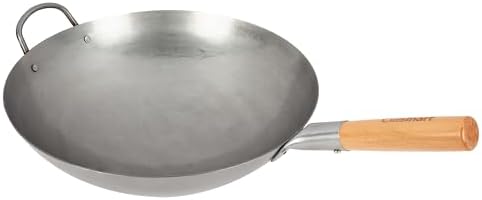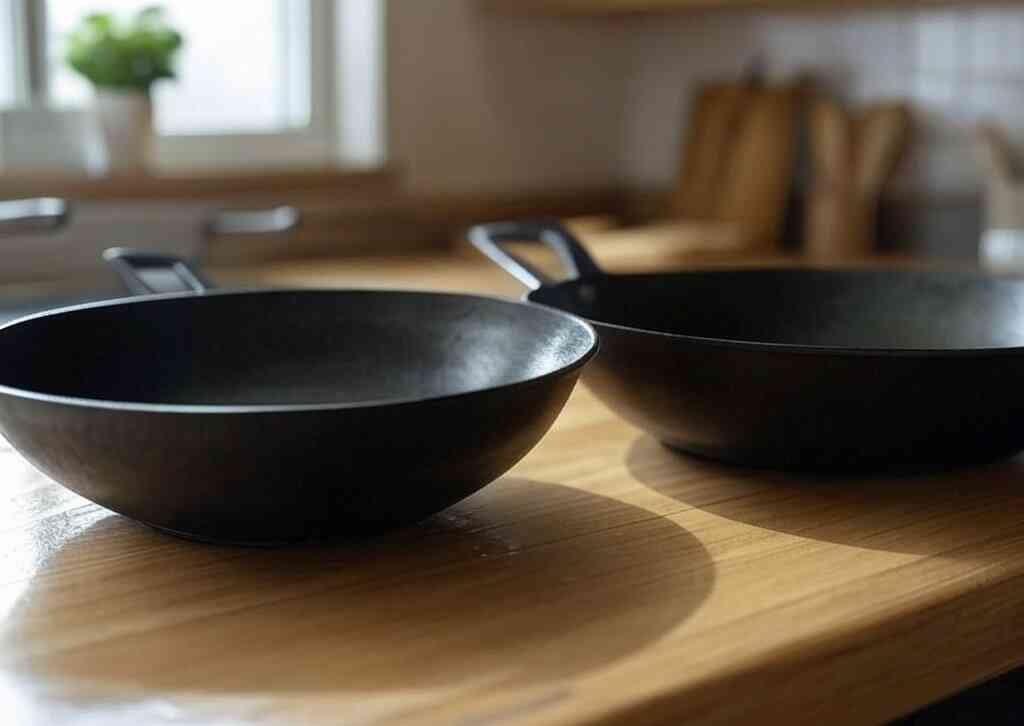What is a Wok?
A wok is a round-bottomed cooking pot. It is originally from China but is popularly used in other cuisines in Asia. Its unique shape gives it a bigger cooking surface area compared to regular pans. This makes it best suited for high-heat cooking techniques such as stir-frying. Woks usually have rounded and deep sides. These allow food to be easily tossed and stirred about. This stops food from spilling out when cooking.
The material used to make a wok is vital to its functioning. Carbon steel is what is used most to make traditional woks. It has the advantage of being lightweight. It also gets hot quite fast compared to other metals. This type of wok develops a natural non-stick surface when used over time as it is seasoned. This makes it more functional and better for seasoning food. Some of the materials utilized include cast iron, which retains heat, and stainless steel, which is strong and low-maintenance. Contemporary non-stick woks are likewise very widespread today. The reason for this is that they are convenient to work with and clean. This makes wok cooking accessible to many people. Woks vary in design by material and the presence of handles.
Some woks have one extended handle to one side. This is suitable for tossing food. Other ones have two brief handles. These provide support when dealing with heavier recipes. This versatility provides cooks the means of using many various methods of cooking. These include steaming and braising, and stir-frying. At the end of the day, the unique characteristics of a wok make it a crucial appliance. This is both for restaurants and home cooking. It is useful in a vast array of cooking methods. The Origin of the Wok
The wok, which is a divine cookware, originated around 2000 years ago in ancient China.
People used to make woks during early times using bronze.
Bronze was extensively used during those periods. These woks served multiple purposes. These were boiling, frying, and steaming. The wok evolved with time. It suited the cooking culture and needs of the time. This amazing adaptability is one of the main reasons it has persisted in being at the center of Chinese and global cooking. Geography and culture in China created the wok in large measure. The character of materials like carbon steel and cast iron played heavily towards the evolution of the features of the wok. People appreciated cast iron because it had a better heat retention ability and consistent cooking.
It was popular between the Ming and Qing dynasties. Carbon steel, on the contrary, became the preferred substance in today’s world. It was because it was lighter and heated quickly. This made it ideal for stir-frying. The curved bottom of the wok ensures proper heat transfer. This enables multiple cooking techniques. They include frying, steaming, and braising. It is useful in stir-frying. Stir-frying is a method that involves quick cooking.
It helps achieve the desired flavor and texture of the ingredient. When trade widened, the wok spread across China. Different communities across Asia utilized it. It shows its worldwide importance. In addition to its purpose, the wok also has cultural significance. It is a symbol of harmony in Chinese cooking. This mirrors the harmony of flavor and regard for ingredients. The history of the wok is, thus, more than about a cooking pot. It is symbolic of the rich culture and evolving cuisine of a nation. The History of Wok Usage Across Cultures The wok, that versatile cooking vessel traditionally associated with Chinese cooking, has a rich history.
It dates much further than its origins.
Its arrival in Southeast Asian countries had a profound influence on regional cuisine.
They are Thailand, Malaysia, and Vietnam.
With these nations embracing the wok, they adapted. They used it to suit local ingredients and cooking techniques. This produced unique variations. These reflect the diverse gastronomic landscapes of the areas. For example, within Thai cooking, the wok is required for stir-frying foods such as pad thai. This illustrates how it is used in both old and new recipes. The wok’s diffusion into Western cuisines represents an important page in its history. This aside from Southeast Asia. The late 20th century observed increased enthusiasm for Asian cookery methods. This was also partially due to increased globalization and immigration. This shift led to the use of the wok in home and commercial kitchens in North America and Europe.
Woks entered the cooking arsenals of chefs. They utilized the wok to create dishes that satisfy the traditional Chinese taste as well as Western palates. From high-end fusion cuisine to home cooking, the wok’s versatility made it transcend cultures. Additionally, communal cooking is a critical role of the wok. This aspect holds cultural significance in the majority of societies. Its circular and high sides make it ideal for preparing meals. The meals are shared together. This generally leads to family-style meals.
These encourage bonding and have cultural identity. The wok is more than a cooking tool. It also embodies the social quality of food itself. It highlights the importance of communal dining in societies. As the wok keeps innovating and influencing cooks worldwide, its enduring legacy is proof of the wok’s place in world culinary cultures. Wok Cooking Techniques and Traditions The wok is a most versatile cooking vessel. It accommodates different techniques. These support varied cooking cultures. One of the key methods is stir-frying.
It is a fast and efficient technique.
It is cooking food under high heat with a limited amount of oil. Chefs prefer cutting ingredients into uniform pieces. This ensures equal cooking. This makes it the ideal one to apply in the quick preparation of vegetables, meat, and noodles. It also preserves their taste and texture. The curved sides and flat bottom of the shape of the wok facilitate tossing. The shape also ensures that food is cooked evenly. Deep-frying is also a favorite technique. It is leveraging the wok’s capacity. It can accommodate much oil. Chefs completely submerge foods like dumplings and spring rolls in hot oil. This creates crunchy surfaces and soft interiors. The design of the wok helps in retaining heat. This makes it perfect for achieving that golden-brown finish.
Steaming is another wonderful method of cooking. It typically involves employing a cooling rack or bamboo steamer in the wok. This process is especially healthy. It retains the nutrients of vegetables and proteins. It cooks them slowly without the utilization of too much fat. The majority of traditional foods utilize this method. Baozi or dim sum are some examples. It guarantees obtaining delicate textures. Even grilling can be done using the wok. Specialized equipment like wok grills can completely change the cooking process. They allow tasty smoky flavors in vegetables and meats too. Maintenance and care of the wok, regardless of the process, is of prime importance.
Seasoning is imperative.
It creates a non-stick surface and introduces improved flavor. It typically involves a layer of oil and heating it. This coats evenly. It requires gentle cleaning. This avoids ruining the seasoning. It can be done using a soft sponge and minimal soap. A wok can last an eternity if handled properly. It has unlimited potential in the kitchen.












[…] round bottom wok is the traditional option in Chinese cuisine. It is meant to be used with open flames and enables […]